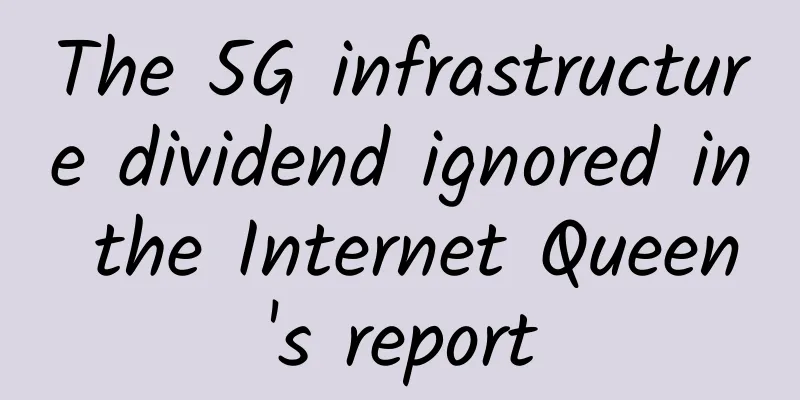The 5G infrastructure dividend ignored in the Internet Queen's report

|
Since 1995, Mary Meeker, known as the "Queen of the Internet", has released an "Internet Report" every year. Most of the observations and predictions in the report have come true. It is known as the Bible of technology investment. The "2019 Internet Report" released on June 12, 2019 is the 24th one, and of course it has attracted the attention of the industry. In recent years, the development trend of the Internet has focused more on mobile Internet, and most of the business forms are formed around smartphone users. These business forms have benefited greatly from the improvement of communication infrastructure, among which 4G network is the largest and most successful communication infrastructure investment in the past five years. Today, 5G commercial licenses have been issued, and the construction of 5G communication infrastructure has been put on the agenda. Based on this infrastructure, Internet applications are undergoing new changes.
Communications infrastructure provides wings for the rapid development of mobile Internet In the past few years, the Internet Trends Report has included a special chapter on the development of China's Internet, written by Hillhouse Capital. The report shows that in recent years, China's Internet industry has maintained a relatively fast growth rate. In 2018, China's mobile Internet users reached 820 million, and mobile Internet data traffic increased by 189% year-on-year. Among them, short videos have contributed greatly to the growth of China's Internet traffic and usage time. From April 2017 to April 2019, the average daily usage time of short video apps in China increased from less than 100 million hours to 600 million hours. Source: Hillhouse Capital In this year’s Internet Trends Report, Hillhouse Capital also mentioned:
The speed of China's mobile Internet development may be more intuitive through some data. According to the latest "Statistical Report on the Development of China's Internet" released by the China Internet Network Information Center, as of December 2018, the domestic mobile Internet-related figures include:
It is precisely because of these user scales that many large domestic Internet companies and Internet applications have emerged, including WeChat, Alipay, Meituan, Didi, Toutiao, etc. Mobile Internet has profoundly changed all aspects of our lives, including food, clothing, housing and transportation. These user scales are closely related to the deployment progress of domestic communication infrastructure. The commercial use of domestic 3G/4G networks and the growth of user scale provide a user base for mobile Internet. In December 2008, China officially issued 3G licenses. By the end of 2009, the number of 3G users reached 12 million. With the continuous improvement of 3G network deployment, the number of 3G users reached 480 million in 2014. Development history of 3G users in China (Unit: 10,000 households, source: Ministry of Industry and Information Technology) By the end of 2013, China officially issued 4G licenses, and the growth rate of 4G users far exceeded that of 3G. In the first year after the licenses were issued, there were nearly 100 million users, and by the end of last year, the number of users had exceeded 1.1 billion. This number of 1.1 billion users constitutes the basis for the number of users of major mobile Internet manufacturers. So far, China has built a 4G network with the world's largest coverage depth and breadth, allowing Internet applications to be accessed anytime and anywhere. The Internet Queen Report reveals a key point of "China and the United States monopolizing the top Internet companies". The author believes that strong 4G infrastructure and user support are an important condition for Chinese Internet companies to join the global top echelon. Development history of China's 4G user numbers (unit: 10,000 households, source: Ministry of Industry and Information Technology) The rich applications and huge user scale of the mobile Internet have brought about a rapid growth in traffic. Especially after the commercial use of 4G, domestic mobile Internet traffic has formed a rapid growth trend. The explosive growth of traffic and the emergence of various innovative models of Internet changing food, clothing, housing and transportation are unimaginable in the early days of 4G commercialization, and it is even more impossible to drive it through a regular "plan" or industrial policy. It can be said that this infrastructure dividend cannot be ignored. The continuous decline in communication prices has lowered the threshold for Internet applications In addition to infrastructure construction and user growth, the continuous reduction of communication costs is also a basic condition for the rapid prosperity of the domestic mobile Internet. In January 2019, the Ministry of Industry and Information Technology released the "Economic Operation of the Internet and Related Service Industries in 2018". The monitoring data showed that in 2018, my country's Internet and related service companies above a certain scale achieved business revenue of 956.2 billion yuan, an increase of 20.3% over the previous year. The Ministry of Industry and Information Technology pointed out in its analysis of the data: The communication industry has achieved remarkable results in increasing network speed and reducing fees. The network speed-up has improved the experience of online consumption, and the reduction in fees has lowered the threshold for using Internet applications. Internet companies have strong innovation and entrepreneurship vitality in various fields such as online education, online travel, online sales, and audio and video, promoting the vigorous development of "happiness industries" such as tourism, culture, sports, health, and elderly care, and driving the rapid growth of Internet business revenue. The decline in the cost of the communications industry is clearly reflected in the price index. In the perception of most ordinary people, the price index has been rising overall, and currency depreciation is going on simultaneously. However, among all the goods and services that make up the price index, the price of communications is the only one that continues to decline. In the recently released May Consumer Price Index (CPI) data, against the backdrop of an overall CPI increase of 2.7%, the price index of communications tools and communications services both fell by more than 1%. China's sub-sector price index over the past 20 years It is not just a short-term price drop, but in the long run, communication prices continue to fall. As shown in the above figure, in the past 20 years, from the data of various sub-sectors of urban prices, communication prices have fallen the most. While most consumer prices have risen, communication prices have continued to fall and have never risen. Compared with 20 years ago, communication prices have almost been halved. Nowadays, when we use various mobile Internet apps every day, we don’t seem to consider the cost of network traffic too much. The continuous decline in the prices of communication tools and communication services over the years has brought certain dividends to the domestic Internet. 5G infrastructure dividends empower industries: the entire national economy benefits From the perspective of the development history of the Internet, the commercial use of 3G/4G networks has empowered various Internet applications. Internet giants such as WeChat, Meituan, Didi, Toutiao, Kuaishou, Pinduoduo, etc. were all launched and grew up on the basis of 3G/4G network construction and user growth. According to the national standard of "National Economic Industry Classification", the Internet and related services belong to the category of "information transmission, software and information technology services", and the direct income from the Internet is included in this category. Of course, the Internet also indirectly promotes the development of many industries. For example, the development of e-commerce has promoted the explosive growth of the logistics industry, and the growth of the transportation, warehousing and postal industries; the migration of online shopping to mobile terminals has also promoted the rapid growth of the retail industry. It can be said that these industries in the national economy are all industries that have changed after the 3G/4G infrastructure is ready. Source: China Statistical Yearbook 2018 (Unit: 100 million yuan, drawn by IoT Think Tank) However, we checked the China Statistical Yearbook and found that these industries are only a minority of the major industries in the national economy, and they are mainly centered around people's consumption and related supporting areas. Although "Internet +" has been continuously promoted in recent years, it has not penetrated into the production and operation processes of various industries, so it has not been able to achieve substantial transformation and upgrading in other industries. "5G changes society" is not just a slogan. As 80% of 5G is used in the Internet of Things, it can provide strong support for the digital transformation of core businesses in various industries. Unlike 3G/4G, 5G empowers and changes all walks of life in the national economy. The scale of some industries far exceeds the output scale brought by the original Internet industry, and the dividends of 5G infrastructure are beginning to be released. First, new Internet terminals and formats will emerge in the future. "To get rich, build roads first." In the past few decades, the improvement of infrastructure has contributed greatly to the economic development of many regions. However, "road builders" may not know how users use them, what kind of vehicles they drive, what goods they transport, and what business models they have. But as long as wider and faster roads are built, there will definitely be innovators who will make good use of them. Mobile communications are similar. Network builders will not anticipate what new applications will appear on this network. In the past few years, after the commercial use of 3G/4G networks, various large-scale Internet formats were not expected by people before, nor were they supported by planning and policies. Operators build a strong network infrastructure, and a large number of innovations will naturally follow.
3G/4G gave birth to these Internet formats, and the 5G era will definitely not stop there, because 5G has more technological upgrades than 4G. In the next 5-10 years, Internet innovation will continue to emerge to a large extent as 5G infrastructure is improved. The consumer-grade mobile smart terminals spawned by 5G are not just smartphones, but also a large number of smart hardware that can be connected to the Internet. These smart hardware will definitely form new Internet formats that are different from the past. It can be predicted that in the next few years' "Internet Trend Report", new Internet business models and Internet terminals formed on the basis of 5G will be included in the Internet Queen's key attention and predictions. Secondly, the digital transformation of various vertical industries will create a larger market space From the data of China Statistical Yearbook, we can see that manufacturing is the largest industry in the national economy, and the added value of the industry exceeded 20 trillion in 2016. In the past, the manufacturing industry did not have much to do with 4G, but now the manufacturing industry is actively embracing 5G. 5G's uRLLC application scenarios, network slicing and other innovations are the technologies that support the digital transformation of the core business of the manufacturing industry. During the previous 5G pilot period, there were also a large number of trial commercial cases of intelligent manufacturing. In addition, other traditional industries have also formed a large demand for 5G in the process of digital transformation. In the past few years, most of the 5G cases demonstrated by various manufacturers around the world are IoT application scenarios for various industries. It can be said that 5G has been inseparable from various vertical industries since its birth, which was rare in the past 3G/4G.
Since 5G is aimed at all industries in the national economy, the market scale brought by its support for vertical industries is even larger. Previously, GE proposed an estimate of "1% and 1 trillion" in the white paper "Industrial Internet: Breaking the Boundary between Intelligence and Machines", that is, a 1% improvement in the efficiency of the Industrial Internet will create a market of 1 trillion US dollars. For example, if the production efficiency of global gas-fired power plants increases by 1%, fuel worth 66 billion US dollars will be "saved"; if the capital utilization rate of oil and gas exploration and development increases by 1%, capital expenditure will be reduced by nearly 90 billion US dollars each year. Similarly, 5G's support for the digital transformation of various industries has greatly improved industry efficiency. Even if it supports a 1% increase in efficiency, it will form a huge market scale. For example, 1% of the manufacturing industry is an output scale of hundreds of billions. At present, China has entered the period of formal commercial use of 5G. Judging from the development trend of the price index in the past 20 years, the price of communication services brought by 5G will continue to decline in the future, providing huge dividends for the digital transformation of all walks of life in the national economy. This year's "Internet Trends Report" shows that due to the Internet penetration rate exceeding 50%, the global Internet demographic dividend continues to decline. The Internet Queen emphasized in the report that new growth points are still hard to find. However, in my opinion, although the demographic dividend is declining, the infrastructure dividend is taking shape. With the support of global 5G commercial use, new Internet formats and new terminals will continue to emerge in the future. More importantly, the industrial Internet based on this infrastructure and supported by various IoT solutions will bring new market space, and new growth points are not difficult to find. |
<<: Essential for IoT experts: Network protocol stack LwIP (I)
>>: One article to understand SAN network composition and daily operation and maintenance
Recommend
LoRaWAN for public, private and hybrid networks
Established network connectivity technologies off...
UFOVPS National Day promotion starts at 30% off, top up 200 yuan and get 20 yuan, Hong Kong CN2/Japan CN2 optional
UFOVPS is currently carrying out a National Day p...
RepriseHosting: $28.54/month-L5640/16G memory/240G SSD+8TB HDD/1Gbps bandwidth/Seattle data center
RepriseHosting recently launched a limited-editio...
Created a debuggable gRPC GUI client
[[437208]] This article is reprinted from the WeC...
Frontier | The Internet of Vehicles security ecosystem is taking shape
Internet of Vehicles Security Requires a Platform...
Efficient transfer tips, revealing the pros and cons of Rsync and SCP, helping you make a wise choice!
In daily operation and maintenance work, file tra...
Gartner: Global 5G network infrastructure spending will nearly double in 2020
Recently, according to the forecast of Gartner, a...
The three major operators released their third quarter financial reports. The transformation has been effective but there is still a long way to go.
Recently, the three major telecom operators have ...
HostVDS: $0.99/month - 1GB/10GB/50M-200M bandwidth/Russia & Dallas data centers
HostVDS has been established for some time. The m...
5G is more complex than you think
In the future, 5G networks are developing in the ...
Results announced! Ruishu Information won the grand prize of "2021 Cybersecurity Outstanding Innovation Achievement Competition"
After the Nanjing Station in August and the Beiji...
SoftShellWeb: 30% off VPS in Taiwan/Netherlands/San Jose, 1Gbps unlimited traffic from $3.5/month
SoftShellWeb has launched a promotion for all VPS...
Ubuntu 18.04 changes the IP address
My memory is getting worse and worse, just record...
Verizon expands 5G enterprise network to 24 cities in the U.S.
Beijing time, April 16th morning news, the larges...









